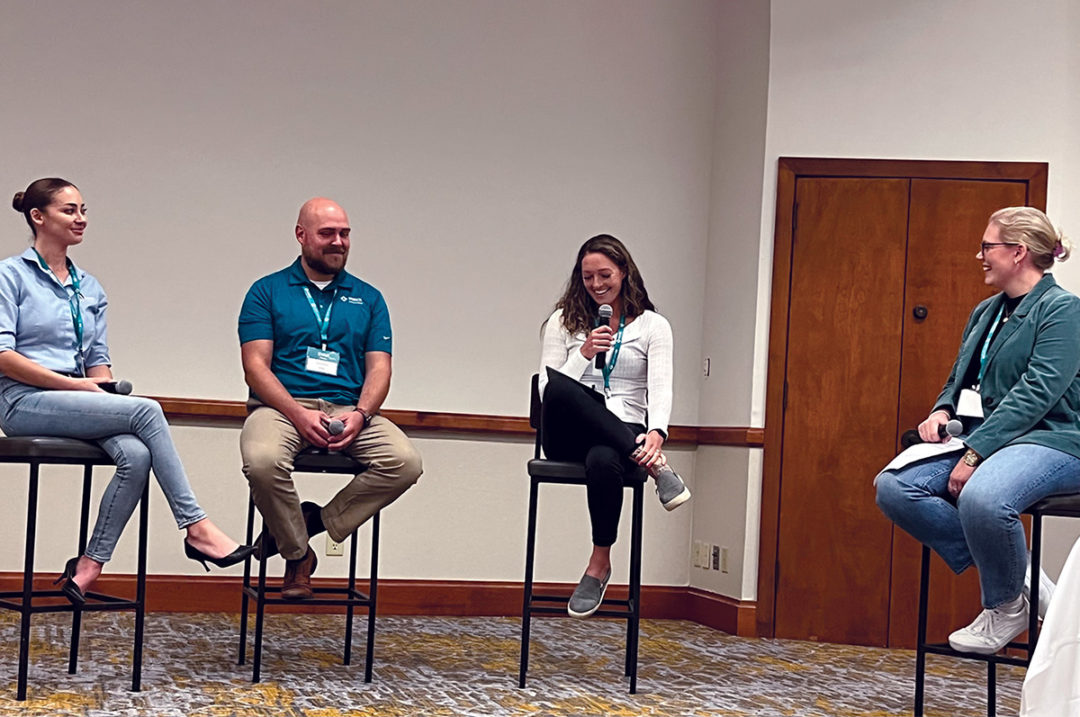Compliance and building a beneficial team culture are two of the greatest labor challenges observed by Michelle Kohls from Kohls Dairy Farm in Wisconsin, Helen Korzec with GPS Nutrition and Evan Platte with Merck Animal Health.
As part of a media event hosted by Merck Animal Health, Kohls, Korzec and Platte discussed how dairies are navigating these obstacles during a panel discussion moderated by Merck Animal Health’s Erica Tessmann.
Technology’s impact on compliance and work environment
Although Kohls said they do not have many labor challenges on their dairy, protocol drift was one that came to mind. However, she said explaining the reason behind why they do things a certain way helps with employee compliance.
Korzec agreed that “explaining is how you get compliance,” and she emphasized the importance of utilizing the data provided by monitoring technology.
“If you don’t measure it, you can’t manage it. I tell every producer I work with that. These technologies are an excellent way for us to manage employees [and improve compliance] through measurement,” Korzec said.
Managers can also use this data to develop reports, graphs and other visuals to show how specific actions affect the cows.
“Keeping things visual and having the tools to show them that you aren’t blowing smoke is a huge deal,” Korzec said. “I never go into those conversations without data to back up what I’m going to address. We can also use the graphs and monitoring reports to showcase how well things are going to celebrate the successes, as well as to discuss how we are going to get to our next success. As dairy farmers, we are notoriously bad at giving positive feedback. It’s important to take the opportunity to not only correct someone when they are not doing a good job, but also to say ‘you’re doing a good job’ when they are doing things correctly.”
Work-life balance is another benefit Kohls noticed since implementing a monitoring system on her dairy.
“It used to take two or three people all day to manage the cows, give shots, look at fresh cows, etc.,” Kohls said. “We built the new barn in 2021 and then added the Allflex dairy monitoring system, which is now SenseHub Dairy by Merck Animal Health, at about the same time. Work-life balance is much better now since I can monitor everything from home on the weekend instead of needing to be at the farm all day every day.”
Besides creating better work-life balance for owners and managers, technology can also make employees’ jobs easier and more enjoyable. Platte correlated this with higher compliance, and he provided an example of how using a sorting gate to automate the process of searching for specific cows in the pen can improve labor efficiency.
“When we talk about our skilled labor force, do we want them out there in the barn searching for cows all day? No, we want them doing what they do best – diagnosing and treating animals,” Platte said. “If an employee knows when they’re going into work that they’re going to be sorting cows all day and doing all that manual labor, they’re probably not looking forward to that. If we can automate this process with technology through monitoring, sort gates, milking equipment, etc., it creates a better work environment that makes employees happy to be at work.”
There is also a “huge animal health aspect” in addition to the labor benefits associated with technology like sort gates, Korzec added.
“If I can get a cow back to her pen sooner, and she eats 1 extra pound of dry matter because I didn’t have to move her around, that’s translating directly to milk production,” she said. “There is also less time away from the feedbunk and away from resting.”
Career development + culture = employee retention
Creating long-term employees starts on day 1 of their employment.
“Every farm should have an onboarding plan for every employee,” Korzec said. “I set up some onboarding plans when I was more into managing herds [earlier in my career] where we gave new employees a small welcome packet. It included information like where the grocery store is, the name of a buddy that can help them, and the times and locations of the English class held in town, for example. Showing new employees that we want them here and we want them to be successful starting on day 1 is very important.”
As employees progress through their career at the dairy, Korzec said technology can create “massive opportunities” for growth.
“When you’re talking about your career on the dairy, you’re actually calling it a career now,” she said. “When there’s opportunity for growth, that’s how you create long-term employees.”
Platte agreed and added that “by having that technology, you really open up the opportunity for multiple employees to be able to advance to higher positions with more responsibility.”
Kohls also concurred that opportunities for advancement improve employee retention. She also discussed the impact of building a family-like culture and some of the ways they have done that at Kohls Dairy Farm.
“We provide them housing – the same housing that I would want to live in,” Kohls said. “I go to their birthday parties, and we invite them to our kids’ birthday parties. If you want to retain labor, you can’t treat them like someone who is just here for the summer.”
Other panelists echoed how workplace culture directly affects retention.
“Retention comes from the culture,” Korzec said. “The reason that people stay is because they’re passionate and they know why they are doing what they are doing. There’s a lot of things you can do to build culture. Again, provide positive feedback along with training. I also work with some dairies that do unique things like setting up a food truck once a month.”
Finding the right position on the farm for each employee involves spending time with them, she added.
“I try to get to know the employees personally on the farms I work with,” Korzec said. “Knowing where the employee fits best on the dairy [based on their background and skill set] requires you getting to know them. Find where they fit, put them in the correct seat, and they’re going to take off, and you’re going to retain them.”
Additionally, Korzec encouraged managers to regularly interact with employees in the barn while they are working.
“I think the best cultures are on farms that have a very engaged management team who are actually out in the barns with the employees,” she said. “They know each other, they know the routine, and they have tried the job and understand the job. There’s nothing like getting instruction from somebody who sits in the office all day.”
She also recommended that managers learn to “communicate properly” in the language that everyone understands. If that is Spanish, then “someone needs to learn Spanish."
“Having someone that can speak Spanish or speak whichever language employees understand is number one,” Korzec said. “I think that everybody should be able to communicate with their employees fully, and that means that managers learn to be bilingual. That’s what we’re facing with our labor force, and having everyone on the same page is important.”
For owners and managers who find managing people to be challenging, Korzec recommended working with a professional who specializes in this area.
“If you don’t like working with people, find yourself a consultant can guide you through it,” Korzec said. “This is really important if you don’t have a burning passion to build a culture. There are people that do, so bring them in.”







